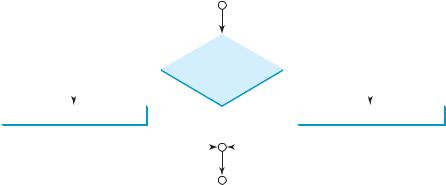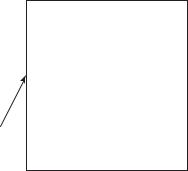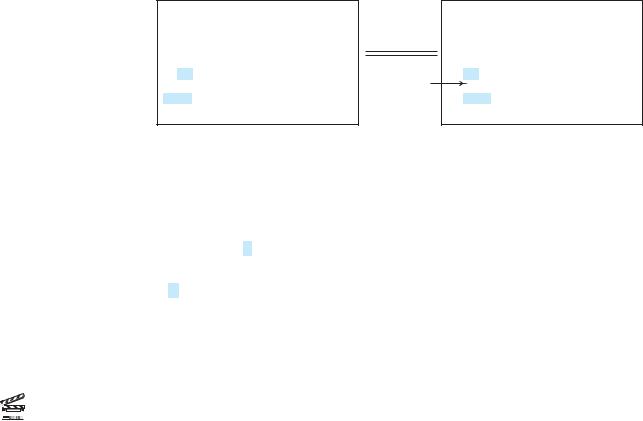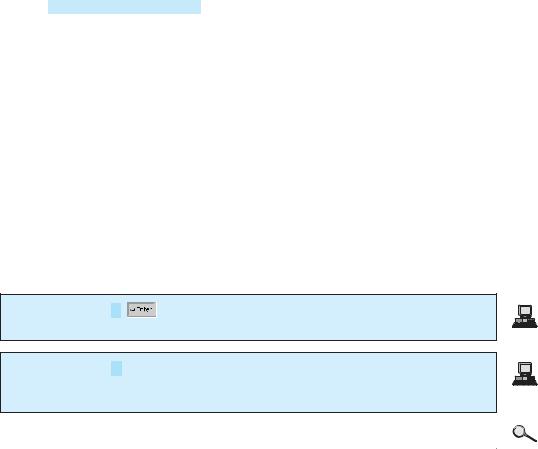
- •CONTENTS
- •1.1 Introduction
- •1.2 What Is a Computer?
- •1.3 Programs
- •1.4 Operating Systems
- •1.5 Java, World Wide Web, and Beyond
- •1.6 The Java Language Specification, API, JDK, and IDE
- •1.7 A Simple Java Program
- •1.8 Creating, Compiling, and Executing a Java Program
- •1.9 (GUI) Displaying Text in a Message Dialog Box
- •2.1 Introduction
- •2.2 Writing Simple Programs
- •2.3 Reading Input from the Console
- •2.4 Identifiers
- •2.5 Variables
- •2.7 Named Constants
- •2.8 Numeric Data Types and Operations
- •2.9 Problem: Displaying the Current Time
- •2.10 Shorthand Operators
- •2.11 Numeric Type Conversions
- •2.12 Problem: Computing Loan Payments
- •2.13 Character Data Type and Operations
- •2.14 Problem: Counting Monetary Units
- •2.15 The String Type
- •2.16 Programming Style and Documentation
- •2.17 Programming Errors
- •2.18 (GUI) Getting Input from Input Dialogs
- •3.1 Introduction
- •3.2 boolean Data Type
- •3.3 Problem: A Simple Math Learning Tool
- •3.4 if Statements
- •3.5 Problem: Guessing Birthdays
- •3.6 Two-Way if Statements
- •3.7 Nested if Statements
- •3.8 Common Errors in Selection Statements
- •3.9 Problem: An Improved Math Learning Tool
- •3.10 Problem: Computing Body Mass Index
- •3.11 Problem: Computing Taxes
- •3.12 Logical Operators
- •3.13 Problem: Determining Leap Year
- •3.14 Problem: Lottery
- •3.15 switch Statements
- •3.16 Conditional Expressions
- •3.17 Formatting Console Output
- •3.18 Operator Precedence and Associativity
- •3.19 (GUI) Confirmation Dialogs
- •4.1 Introduction
- •4.2 The while Loop
- •4.3 The do-while Loop
- •4.4 The for Loop
- •4.5 Which Loop to Use?
- •4.6 Nested Loops
- •4.7 Minimizing Numeric Errors
- •4.8 Case Studies
- •4.9 Keywords break and continue
- •4.10 (GUI) Controlling a Loop with a Confirmation Dialog
- •5.1 Introduction
- •5.2 Defining a Method
- •5.3 Calling a Method
- •5.4 void Method Example
- •5.5 Passing Parameters by Values
- •5.6 Modularizing Code
- •5.7 Problem: Converting Decimals to Hexadecimals
- •5.8 Overloading Methods
- •5.9 The Scope of Variables
- •5.10 The Math Class
- •5.11 Case Study: Generating Random Characters
- •5.12 Method Abstraction and Stepwise Refinement
- •6.1 Introduction
- •6.2 Array Basics
- •6.3 Problem: Lotto Numbers
- •6.4 Problem: Deck of Cards
- •6.5 Copying Arrays
- •6.6 Passing Arrays to Methods
- •6.7 Returning an Array from a Method
- •6.8 Variable-Length Argument Lists
- •6.9 Searching Arrays
- •6.10 Sorting Arrays
- •6.11 The Arrays Class
- •7.1 Introduction
- •7.2 Two-Dimensional Array Basics
- •7.3 Processing Two-Dimensional Arrays
- •7.4 Passing Two-Dimensional Arrays to Methods
- •7.5 Problem: Grading a Multiple-Choice Test
- •7.6 Problem: Finding a Closest Pair
- •7.7 Problem: Sudoku
- •7.8 Multidimensional Arrays
- •8.1 Introduction
- •8.2 Defining Classes for Objects
- •8.3 Example: Defining Classes and Creating Objects
- •8.4 Constructing Objects Using Constructors
- •8.5 Accessing Objects via Reference Variables
- •8.6 Using Classes from the Java Library
- •8.7 Static Variables, Constants, and Methods
- •8.8 Visibility Modifiers
- •8.9 Data Field Encapsulation
- •8.10 Passing Objects to Methods
- •8.11 Array of Objects
- •9.1 Introduction
- •9.2 The String Class
- •9.3 The Character Class
- •9.4 The StringBuilder/StringBuffer Class
- •9.5 Command-Line Arguments
- •9.6 The File Class
- •9.7 File Input and Output
- •9.8 (GUI) File Dialogs
- •10.1 Introduction
- •10.2 Immutable Objects and Classes
- •10.3 The Scope of Variables
- •10.4 The this Reference
- •10.5 Class Abstraction and Encapsulation
- •10.6 Object-Oriented Thinking
- •10.7 Object Composition
- •10.8 Designing the Course Class
- •10.9 Designing a Class for Stacks
- •10.10 Designing the GuessDate Class
- •10.11 Class Design Guidelines
- •11.1 Introduction
- •11.2 Superclasses and Subclasses
- •11.3 Using the super Keyword
- •11.4 Overriding Methods
- •11.5 Overriding vs. Overloading
- •11.6 The Object Class and Its toString() Method
- •11.7 Polymorphism
- •11.8 Dynamic Binding
- •11.9 Casting Objects and the instanceof Operator
- •11.11 The ArrayList Class
- •11.12 A Custom Stack Class
- •11.13 The protected Data and Methods
- •11.14 Preventing Extending and Overriding
- •12.1 Introduction
- •12.2 Swing vs. AWT
- •12.3 The Java GUI API
- •12.4 Frames
- •12.5 Layout Managers
- •12.6 Using Panels as Subcontainers
- •12.7 The Color Class
- •12.8 The Font Class
- •12.9 Common Features of Swing GUI Components
- •12.10 Image Icons
- •13.1 Introduction
- •13.2 Exception-Handling Overview
- •13.3 Exception-Handling Advantages
- •13.4 Exception Types
- •13.5 More on Exception Handling
- •13.6 The finally Clause
- •13.7 When to Use Exceptions
- •13.8 Rethrowing Exceptions
- •13.9 Chained Exceptions
- •13.10 Creating Custom Exception Classes
- •14.1 Introduction
- •14.2 Abstract Classes
- •14.3 Example: Calendar and GregorianCalendar
- •14.4 Interfaces
- •14.5 Example: The Comparable Interface
- •14.6 Example: The ActionListener Interface
- •14.7 Example: The Cloneable Interface
- •14.8 Interfaces vs. Abstract Classes
- •14.9 Processing Primitive Data Type Values as Objects
- •14.10 Sorting an Array of Objects
- •14.11 Automatic Conversion between Primitive Types and Wrapper Class Types
- •14.12 The BigInteger and BigDecimal Classes
- •14.13 Case Study: The Rational Class
- •15.1 Introduction
- •15.2 Graphical Coordinate Systems
- •15.3 The Graphics Class
- •15.4 Drawing Strings, Lines, Rectangles, and Ovals
- •15.5 Case Study: The FigurePanel Class
- •15.6 Drawing Arcs
- •15.7 Drawing Polygons and Polylines
- •15.8 Centering a String Using the FontMetrics Class
- •15.9 Case Study: The MessagePanel Class
- •15.10 Case Study: The StillClock Class
- •15.11 Displaying Images
- •15.12 Case Study: The ImageViewer Class
- •16.1 Introduction
- •16.2 Event and Event Source
- •16.3 Listeners, Registrations, and Handling Events
- •16.4 Inner Classes
- •16.5 Anonymous Class Listeners
- •16.6 Alternative Ways of Defining Listener Classes
- •16.7 Problem: Loan Calculator
- •16.8 Window Events
- •16.9 Listener Interface Adapters
- •16.10 Mouse Events
- •16.11 Key Events
- •16.12 Animation Using the Timer Class
- •17.1 Introduction
- •17.2 Buttons
- •17.3 Check Boxes
- •17.4 Radio Buttons
- •17.5 Labels
- •17.6 Text Fields
- •17.7 Text Areas
- •17.8 Combo Boxes
- •17.9 Lists
- •17.10 Scroll Bars
- •17.11 Sliders
- •17.12 Creating Multiple Windows
- •18.1 Introduction
- •18.2 Developing Applets
- •18.3 The HTML File and the <applet> Tag
- •18.4 Applet Security Restrictions
- •18.5 Enabling Applets to Run as Applications
- •18.6 Applet Life-Cycle Methods
- •18.7 Passing Strings to Applets
- •18.8 Case Study: Bouncing Ball
- •18.9 Case Study: TicTacToe
- •18.10 Locating Resources Using the URL Class
- •18.11 Playing Audio in Any Java Program
- •18.12 Case Study: Multimedia Animations
- •19.1 Introduction
- •19.2 How is I/O Handled in Java?
- •19.3 Text I/O vs. Binary I/O
- •19.4 Binary I/O Classes
- •19.5 Problem: Copying Files
- •19.6 Object I/O
- •19.7 Random-Access Files
- •20.1 Introduction
- •20.2 Problem: Computing Factorials
- •20.3 Problem: Computing Fibonacci Numbers
- •20.4 Problem Solving Using Recursion
- •20.5 Recursive Helper Methods
- •20.6 Problem: Finding the Directory Size
- •20.7 Problem: Towers of Hanoi
- •20.8 Problem: Fractals
- •20.9 Problem: Eight Queens
- •20.10 Recursion vs. Iteration
- •20.11 Tail Recursion
- •APPENDIXES
- •INDEX

3.6 Two-Way if Statements 79
3.6 Two-Way if Statements
A one-way if statement takes an action if the specified condition is true. If the condition is false, nothing is done. But what if you want to take alternative actions when the condition is false? You can use a two-way if statement. The actions that a two-way if statement specifies differ based on whether the condition is true or false.
Here is the syntax for a two-way if statement:
if (boolean-expression) { statement(s)-for-the-true-case;
}
else { statement(s)-for-the-false-case;
}
The flow chart of the statement is shown in Figure 3.3.
|
true |
boolean- |
false |
|||||
|
|
|
expression |
|
|
|
||
|
|
|
|
|
|
|
|
|
|
|
|
|
|
|
|||
Statement(s) for the true case |
|
|
|
|
|
Statement(s) for the false case |
||
|
|
|
|
|
|
|
|
|
FIGURE 3.3 An if ... else statement executes statements for the true case if the boolean-expression evaluates to true; otherwise, statements for the false case are executed.
If the boolean-expression evaluates to true, the statement(s) for the true case are exe- |
|
cuted; otherwise, the statement(s) for the false case are executed. For example, consider the |
|
following code: |
|
if (radius >= 0) { |
two-way if statement |
area = radius * radius * PI; |
|
System.out.println("The area for the circle of radius " + |
|
radius + " is " + area); |
|
} |
|
else { |
|
System.out.println("Negative input"); |
|
} |
|
If radius >= 0 is true, area is computed and displayed; if it is false, the message
"Negative input" is printed.
As usual, the braces can be omitted if there is only one statement within them. The braces enclosing the System.out.println("Negative input") statement can therefore be omitted in the preceding example.

80 Chapter 3 Selections
Here is another example of using the if ... else statement. The example checks whether a number is even or odd, as follows:
if (number % 2 == 0) System.out.println(number + " is even.");
else
System.out.println(number + " is odd.");
3.7 Nested if Statements
The statement in an if or if ... else statement can be any legal Java statement, including another if or if ... else statement. The inner if statement is said to be nested inside the outer if statement. The inner if statement can contain another if statement; in fact, there is no limit to the depth of the nesting. For example, the following is a nested if statement:
|
if (i > k) { |
nested if statement |
if (j > k) |
|
System.out.println("i and j are greater than k"); |
|
} |
|
else |
|
System.out.println("i is less than or equal to k"); |
|
The if (j > k) statement is nested inside the if (i > k) statement. |
|
The nested if statement can be used to implement multiple alternatives. The statement |
|
given in Figure 3.4(a), for instance, assigns a letter grade to the variable grade according to |
|
the score, with multiple alternatives. |
if (score >= 90.0) |
|
|
grade = 'A'; |
|
|
else |
|
|
if (score >= 80.0) |
|
Equivalent |
grade = 'B'; |
|
|
|
|
|
|
|
|
else |
|
|
if (score >= 70.0) |
|
|
grade = 'C'; |
|
|
else |
|
|
if (score >= 60.0) |
|
This is better |
grade = 'D'; |
|
|
else |
|
|
grade = 'F'; |
|
|
|
|
|
if (score >= 90.0) grade = 'A';
else if (score >= 80.0) grade = 'B';
else if (score >= 70.0) grade = 'C';
else if (score >= 60.0) grade = 'D';
else
grade = 'F';
(a) |
(b) |
FIGURE 3.4 A preferred format for multiple alternative if statements is shown in (b).
The execution of this if statement proceeds as follows. The first condition (score >= 90.0) is tested. If it is true, the grade becomes 'A'. If it is false, the second condition (score >= 80.0) is tested. If the second condition is true, the grade becomes 'B'. If that condition is false, the third condition and the rest of the conditions (if necessary) continue to be tested until a condition is met or all of the conditions prove to be false. If all of the conditions are false, the grade becomes 'F'. Note that a condition is tested only when all of the conditions that come before it are false.
The if statement in Figure 3.4(a) is equivalent to the if statement in Figure 3.4(b). In fact, Figure 3.4(b) is the preferred writing style for multiple alternative if statements. This style avoids deep indentation and makes the program easy to read.

3.8 Common Errors in Selection Statements 81
 Tip
Tip
Often, to assign a test condition to a below:
if (number % 2 == 0) even = true;
else
even = false;
(a)
boolean variable, new programmers write code as in (a) |
assign boolean variable |
||||
|
Equivalent |
|
|
|
|
|
boolean even |
|
|
||
|
|
|
|
|
|
|
|
|
= number % 2 == 0; |
|
|
|
This is shorter |
|
|
||
|
|
|
|
||
|
|
|
(b) |
|
|
The code can be simplified by assigning the test value directly to the variable, as shown in (b).
3.8 Common Errors in Selection Statements
The following errors are common among new programmers.
Common Error 1: Forgetting Necessary Braces
The braces can be omitted if the block contains a single statement. However, forgetting the braces when they are needed for grouping multiple statements is a common programming error. If you modify the code by adding new statements in an if statement without braces, you will have to insert the braces. For example, the code in (a) below is wrong. It should be written with braces to group multiple statements, as shown in (b).
if (radius >= 0)
area = radius * radius * PI; System.out.println("The area "
+" is " + area);
(a)Wrong
if (radius >= 0) {
area = radius * radius * PI; System.out.println("The area "
+ " is " + area);
}
(b) Correct
Common Error 2: Wrong Semicolon at the if Line
Adding a semicolon at the if line, as shown in (a) below, is a common mistake.
|
Logic Error |
|
|
|
|
|
Empty Block |
|
|
|
|
|
|
|
|
if (radius >= 0); |
|
|
|
|
if (radius >= 0) |
{ } |
; |
{ |
|
|
Equivalent |
{ |
|
|
|
area = radius * radius * PI; |
|
area = radius * radius * PI; |
|||||
|
|
|
|||||
System.out.println("The area " |
|
|
|
System.out.println("The area " |
|||
|
|
|
|||||
+ " is " + area); |
|
|
|
+ " is " + area); |
|||
} |
|
|
|
|
} |
|
|
|
|
|
|
|
|||
(a) |
|
|
|
(b) |
|||
This mistake is hard to find, because it is neither a compilation error nor a runtime error; it is a logic error. The code in (a) is equivalent to that in (b) with an empty block.
This error often occurs when you use the next-line block style. Using the end-of-line block style can help prevent the error.
Common Error 3: Redundant Testing of Boolean Values
To test whether a boolean variable is true or false in a test condition, it is redundant to use the equality comparison operator like the code in (a):
if (even == true) |
|
Equivalent |
if (even) |
|
System.out.println( |
|
|
|
System.out.println( |
|
|
|
||
|
|
|
||
"It is even."); |
|
|
|
"It is even."); |
|
|
|
|
|
(a) |
|
This is better |
(b) |
|
|
|
|
||

82 Chapter 3 Selections
Instead, it is better to test the boolean variable directly, as shown in (b). Another good reason for doing this is to avoid errors that are difficult to detect. Using the = operator instead of the == operator to compare equality of two items in a test condition is a common error. It could lead to the following erroneous statement:
if (even = true) System.out.println("It is even.");
This statement does not have syntax errors. It assigns true to even, so that even is always true.
Common Error 4: Dangling else Ambiguity
The code in (a) below has two if clauses and one else clause. Which if clause is matched by the else clause? The indentation indicates that the else clause matches the first if clause. However, the else clause actually matches the second if clause. This situation is known as the dangling-else ambiguity. The else clause always matches the most recent unmatched if clause in the same block. So, the statement in (a) is equivalent to the code in (b).
int i = 1; int j = 2; int k = 3;
if (i > j) if (i > k)
System.out.println("A");
else
System.out.println("B");
(a)
Equivalent
This is better with correct indentation
int i = 1; int j = 2; int k = 3;
if (i > j) if (i > k)
System.out.println("A");
else
System.out.println("B");
(b)
Since (i > j) is false, nothing is printed from the statement in (a) and (b). To force the else clause to match the first if clause, you must add a pair of braces:
int i = 1, j = 2, k = 3;
if (i > j) { if (i > k)
System.out.println("A");
}
else
System.out.println("B");
This statement prints B.
Video Note
Program subtraction quiz
random() method
3.9 Problem: An Improved Math Learning Tool
Suppose you want to develop a program for a first-grader to practice subtraction. The program randomly generates two single-digit integers, number1 and number2, with number1 > = number2 and displays to the student a question such as “What is 9 - 2?” After the student enters the answer, the program displays a message indicating whether it is correct.
The previous programs generate random numbers using System.currentTimeMillis(). A better approach is to use the random() method in the Math class. Invoking this method returns a random double value d such that 0.0 … d 6 1.0. So, (int)(Math.random() * 10) returns a random single-digit integer (i.e., a number between 0 and 9).
The program may work as follows:
■Generate two single-digit integers into number1 and number2.
■If number1 < number2, swap number1 with number2.

3.9 Problem: An Improved Math Learning Tool 83
■Prompt the student to answer “What is number1 – number2?”
■Check the student’s answer and display whether the answer is correct.
The complete program is shown in Listing 3.4.
LISTING 3.4 SubtractionQuiz.java
1 import java.util.Scanner;
2
3 public class SubtractionQuiz {
4public static void main(String[] args) {
5// 1. Generate two random single-digit integers
6 |
int number1 = (int)(Math.random() * |
10); |
random numbers |
7 |
int number2 = (int)(Math.random() * |
10); |
|
8 |
|
|
|
9 |
// 2. If number1 < number2, swap number1 with number2 |
|
|
10if (number1 < number2) {
11int temp = number1;
12number1 = number2;
13number2 = temp;
14}
15
16// 3. Prompt the student to answer "What is number1 – number2?"
17System.out.print
18("What is " + number1 + " - " + number2 + "? ");
19Scanner input = new Scanner(System.in);
20 |
|
int answer = input.nextInt(); |
|
get answer |
||
21 |
|
|
|
|
|
|
22 |
// |
4. Grade the answer and display the result |
|
|||
23 |
|
if |
(number1 - number2 == answer) |
|
check the answer |
|
24System.out.println("You are correct!");
25else
26System.out.println("Your answer is wrong\n" + number1 + " - "
27+ number2 + " should be " + (number1 - number2));
28}
29}
What is 6 - 6? 0
You are correct!
What is 9 - 2? 5  Your answer is wrong 9 - 2 should be 7
Your answer is wrong 9 - 2 should be 7
|
line# |
number1 |
number2 |
temp |
answer |
output |
|
|
|
|
|
|
|
|
|
|
6 |
2 |
|
|
|
|
|
7 |
|
9 |
|
|
|
|
|
11 |
|
|
2 |
|
|
|
|
12 |
9 |
|
|
|
|
|
|
13 |
|
2 |
|
|
|
|
|
20 |
|
|
|
5 |
|
|
|
26 |
|
|
|
|
Your answer is wrong |
||
|
|
|
|
|
|
9 – 2 should be 7 |
|
|
|
|
|
|
|
|
|
